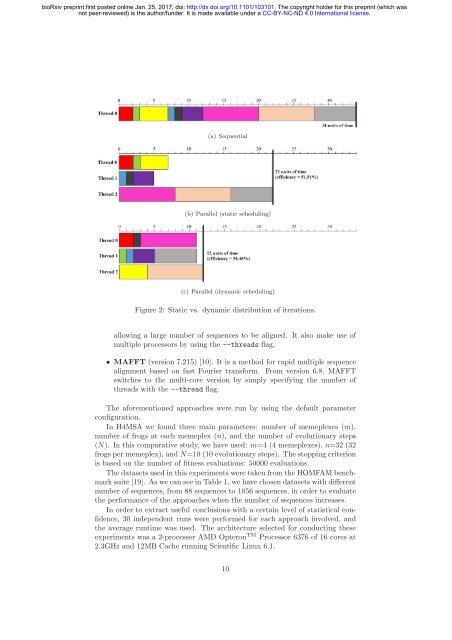different
103101.full
103101.full
Create successful ePaper yourself
Turn your PDF publications into a flip-book with our unique Google optimized e-Paper software.
ioRxiv preprint first posted online Jan. 25, 2017; doi: http://dx.doi.org/10.1101/103101. The copyright holder for this preprint (which was<br />
not peer-reviewed) is the author/funder. It is made available under a CC-BY-NC-ND 4.0 International license.<br />
(a) Sequential<br />
(b) Parallel (static scheduling)<br />
(c) Parallel (dynamic scheduling)<br />
Figure 2: Static vs. dynamic distribution of iterations.<br />
allowing a large number of sequences to be aligned. It also make use of<br />
multiple processors by using the --threads flag.<br />
• MAFFT (version 7.215) [10]. It is a method for rapid multiple sequence<br />
alignment based on fast Fourier transform. From version 6.8, MAFFT<br />
switches to the multi-core version by simply specifying the number of<br />
threads with the --thread flag.<br />
The aforementioned approaches were run by using the default parameter<br />
configuration.<br />
In H4MSA we found three main parameters: number of memeplexes (m),<br />
number of frogs at each memeplex (n), and the number of evolutionary steps<br />
(N). In this comparative study, we have used: m=4 (4 memeplexes), n=32 (32<br />
frogs per memeplex), and N=10 (10 evolutionarysteps). The stopping criterion<br />
is based on the number of fitness evaluations: 50000 evaluations.<br />
Thedatasetsusedin this experimentsweretakenfromthe HOMFAMbenchmark<br />
suite [19]. As we can see in Table 1, we have chosen datasets with <strong>different</strong><br />
number of sequences, from 88 sequences to 1056 sequences, in order to evaluate<br />
the performance of the approaches when the number of sequences increases.<br />
In order to extract useful conclusions with a certain level of statistical confidence,<br />
30 independent runs were performed for each approach involved, and<br />
the average runtime was used. The architecture selected for conducting these<br />
experiments was a 2-processor AMD Opteron TM Processor 6376 of 16 cores at<br />
2.3GHz and 12MB Cache running Scientific Linux 6.1.<br />
10






